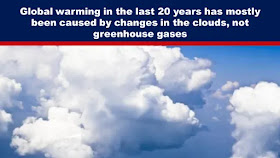An assumption made by the United Nations Intergovernmental Panel on
Climate Change (“IPCC”) in its most recent report is that the warming
caused by the increase in long-wave back radiation was due solely to the
anthropogenic greenhouse effect.
The IPCC attributes 100% of
the warming to this effect and justifies this with model calculations.
However, a study published in 2021 proved this to be incorrect.
he
analysis of the measured data by Rolf Dübal and Fritz Vahrenholt showed
that the warming due to the decrease of short-wave radiation and the
increase in long-wave radiation is mainly attributable to the cloud
effect.
“The direct aerosol effect is rather small, but the
indirect effect via the cloud formation may be larger,” the researchers
noted in their peer-reviewed paper.
The two researchers
investigated the Earth’s radiation balance over the last 20 years in a
peer-reviewed study published in the journal Atmosphere in September
2021. The study titled ‘Radiative Energy flux variation from 2001 –
2020’ brought to light that the warming of the Earth in the last 20
years is mainly due to a higher permeability of clouds for short-wave
solar radiation. The authors came to this clear conclusion after
evaluating the CERES radiation data.
“The warming of the last 20
years has been caused more by change in the clouds than by the
classical greenhouse effect,” they said.
Adding, “The time span
of 20 years is still too short to be able to decide conclusively whether
the current heating phase is a temporary or permanent development. In
the former case, climate forecasts will have to be fundamentally
revised.”...<<<Read More>>>...
